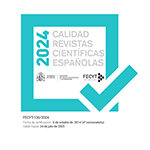"Clori fugiens": aspectos de la imitación de Ovidio en una canción juvenil de Góngora
Abstract
Este trabajo analiza los modelos ovidianos de la canción Corcilla temerosa de Góngora. En dicha composición juvenil el poeta de Córdoba reelabora el motivo de la fuga de la ninfa (Dafne y Apolo) (Met. I, 452-567), combinándolo en algunas estancias con el de la carrera heroica (Atalanta e Hipómenes) (Met. X, 578-662). Ciertos elementos de la descriptio puellae pueden relacionarse asimismo con hipotextos vernáculos (Petrarca, Strozzi, Garcilaso, Della Casa, Tasso), configurando de esa manera un refinado ejercicio de hibridación.
Downloads
##submission.format##
Licenza
La revista Cuadernos de Filología Clásica. Estudios Latinos, para fomentar el intercambio global del conocimiento, facilita el acceso sin restricciones a sus contenidos desde el momento de su publicación en la presente edición electrónica, y por eso es una revista de acceso abierto. Los originales publicados en esta revista son propiedad de la Universidad Complutense de Madrid y es obligatorio citar su procedencia en cualquier reproducción total o parcial. Todos los contenidos se distribuyen bajo una licencia de uso y distribución Creative Commons Reconocimiento 4.0 (CC BY 4.0). Esta circunstancia ha de hacerse constar expresamente de esta forma cuando sea necesario. Puede consultar la versión informativa y el texto legal de la licencia.








